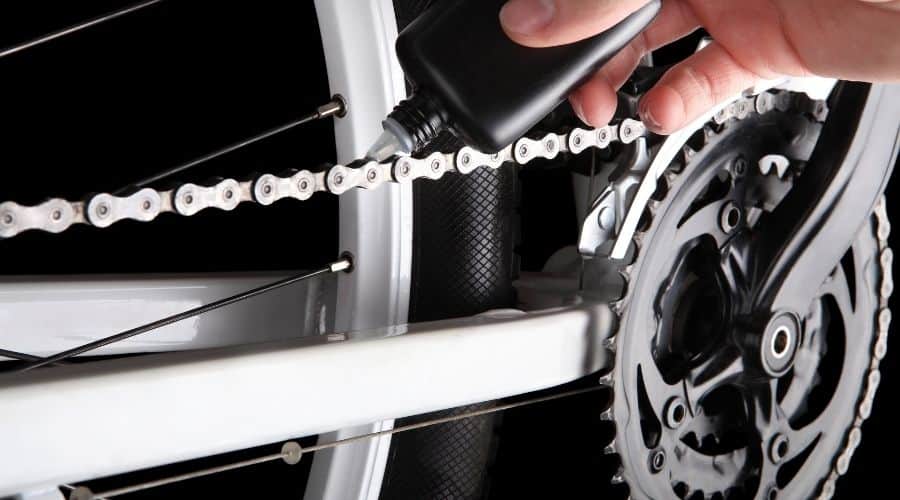Bike chains make a normal sound as they go around due to links connecting with protrusions on the cassette and chainring. Sadly, not all bike chain noises are benign, and when you hear rubbing or grinding, you should always be concerned.
When a metal chain scratches another metal surface, both parts wear down. Why does your bike chain make noise under load?
The main reason your bike chain makes noise under load is that the chainring bends or flexes slightly, which leads to rubbing. The noise comes from two metal parts scraping across each other’s surfaces as you move. You don’t hear it when there’s no load because the flex is slight and caused by weight on the bike.
Recommended Gear
To see all of my up-to-date recommendations for bikes and cycling gear, check out this resource that I made for you!
Table of Contents
Why Does My Bike Chain Make Noise Under Load
Your bike chain makes noise under load because it is taking damage. Regrettably, as Sir Issac Newton so famously said, “To every action, there is always an equal and opposite or contrary reaction.”
In this case, it applies to whatever your chain is rubbing against. Both parts are wearing down abnormally, which can lead to a critical failure.
You don’t want your bike chain to break as you’re riding. Even worse, you certainly don’t want another part to suddenly bend and fail because it’s partially worn through or too worn down to function.
Regular maintenance and inspections will help, but you also need to pay attention to any strange sounds and address them immediately before the problem gets bigger.
Here Are 5 Reasons Why Your Bike Chain Makes Noise Under Load:
1 – Chainring Flex Distorting Chain Line
The chainring is essential to chain movement. This is the spiked, round part connected to your cranks, and without it, there is nothing to hold your chain and advance it forward. If this part is flexing, it will bow either outward or inward.
A chainring flex may not be visually apparent when there’s no load on the bike so that you won’t see it.
However, this piece being out of place as you ride will move the chain out of position slightly, and that causes rubbing against any one of several other parts.
Look for the area that has been rubbed instead of a distorted chainring.
2 – Flexing Frame
I think of metal as inflexible, and you probably do too, but that’s not entirely accurate. It takes a lot of pressure or weight to flex most types of metal, but it will bend if you push hard enough.
Metal that doesn’t bend is too brittle and will break under load, which is a different issue entirely. If your frame starts flexing between the BB and the rear axle, it will cause the chain to rub.
3 – Chainring Worn Through
It is completely normal for a chainring to wear down. As the chain goes around, the links slip over the spiky protrusions on the chainring, and the crank connected to your pedals turns both.
Grit and dirt from the road get between the chain and chainring, which causes grinding despite the lubrication.
Every time you pedal, that metal chain connects with, and with a barrier of lubrication, it rubs on the chainring.
To extend the life of these parts, clean and lubricate them often. Additionally, it would be best if you replaced your chainring when it’s about seventy-five percent worn down.
4 – Dry Chain
Lubrication matters more than you think. In fact, a perfectly lubricated chain could glide over the chainring without wearing either part down forever if there was no dirt to get between the two.
A dry chain makes a noise, but it should be more noticeable under load.
To fix a dry chain, follow these simple steps:
- Clean the chain with a degreaser. You can do this manually with a brush, but I recommend a Park Tool CG-2.4 Bicycle Chain and Drivetrain Cleaning Kit from Amazon. This clever kit has everything you need to get all the grease and dirt off a chain, plus it does most of the work for you.
- Complete cleaning solution for cleaning bike chains, rear cogs, and chainrings
- Includes chain scrubber, gear brush, and degreaser
- Cyclone Chain Scrubber cleans chains quickly, easily, and effectively
- GearClean brush reaches deep between gears and other places where dirt collects
- ChainBrite Chain and Component Cleaning Fluid is plant-based and will not harm alloy, plastic, rubber or carbon fiber
- Ensure that the chain is completely dry.
- Add a drop of bike chain lubricant between every link and rotate the chain a few times around manually by pushing the pedals. Doing this spreads out your lubricant evenly.
5 – Cassette Rubbing
The cassette or collection of sprockets on your rear wheel works a lot like the chainring.
The difference is that you can shift up and down to different sprockets to switch gears—the larger the sprocket, the lower the gear.
Regardless, an overloaded chain will rub against parts of the cassette and make odd noises.
6 – Rear Derailleur Misaligned
Your derailleurs are complex parts. As Wikipedia aptly describes it, “A derailleur is a variable-ratio bicycle gearing system consisting of a chain, multiple sprockets of different sizes, and a mechanism to move the chain from one sprocket to another.”
If your rear derailleur is misaligned, then the chain doesn’t move the way it should. Inevitably that means the chain will be out of place and it will start to grind on other parts.
Adjustments can often be as simple as turning the screws to get things moving correctly again.
I recommend this video for an in-depth review of how to adjust your derailleur to eliminate chain rubbing.
Helpful Tips To Know About Bike Chain Noise Under Load
When your bike chain makes noise under load, it is usually a scraping or grinding sound.
This is caused by metal parts coming together and rubbing where they shouldn’t, which causes damage. You can often hear the sound of that damage.
Here are some more helpful tips to know about bike chain noise under load.
- Under load sounds different than what it actually means. Your bike shouldn’t be under load at all. As Bicycles Stack Exchange puts it, “The shifting under load is a load for which neither the chain nor the gear is designed to resist: by doing that you are inducing microscopical damages to the metal, accelerating the wear of components.”
- To unload your bike, you need to remove the pressure. In this case, that may mean removing weight. This can include carrying less equipment with you as you ride, taking off accessories like baskets and saddlebags, or swapping out parts for more durable parts.
- Under load can also indicate a lot of pedal force, such as riding uphill when mountain biking. In this case, you will need better lubricant, adjustments via the screws, or new parts that can handle the pressure.
Final Thoughts
The upside to a bike chain noise that happens under load is that it is easier to detect, and it’s an indication that you’re putting too much weight or pressure on the parts.
Sometimes you can resolve this by simply removing pouches or a basket carrying too much weight. Unfortunately, if this doesn’t work you may need new bike parts or a sturdier bike.
Identifying the part with issues isn’t the problem when it’s only happening under load because ‘under load’ indicates that the pressure is excessive for the parts.
It might be best to consider swapping your current bike for one that can handle everything you want to carry or the strain of moving uphill.


